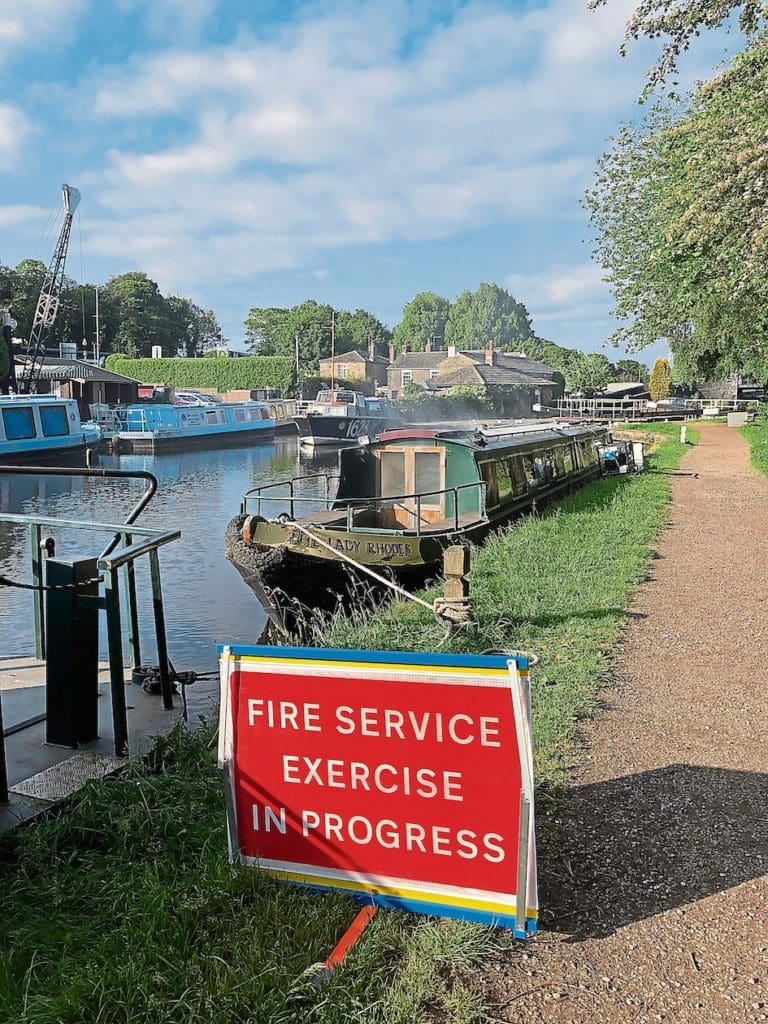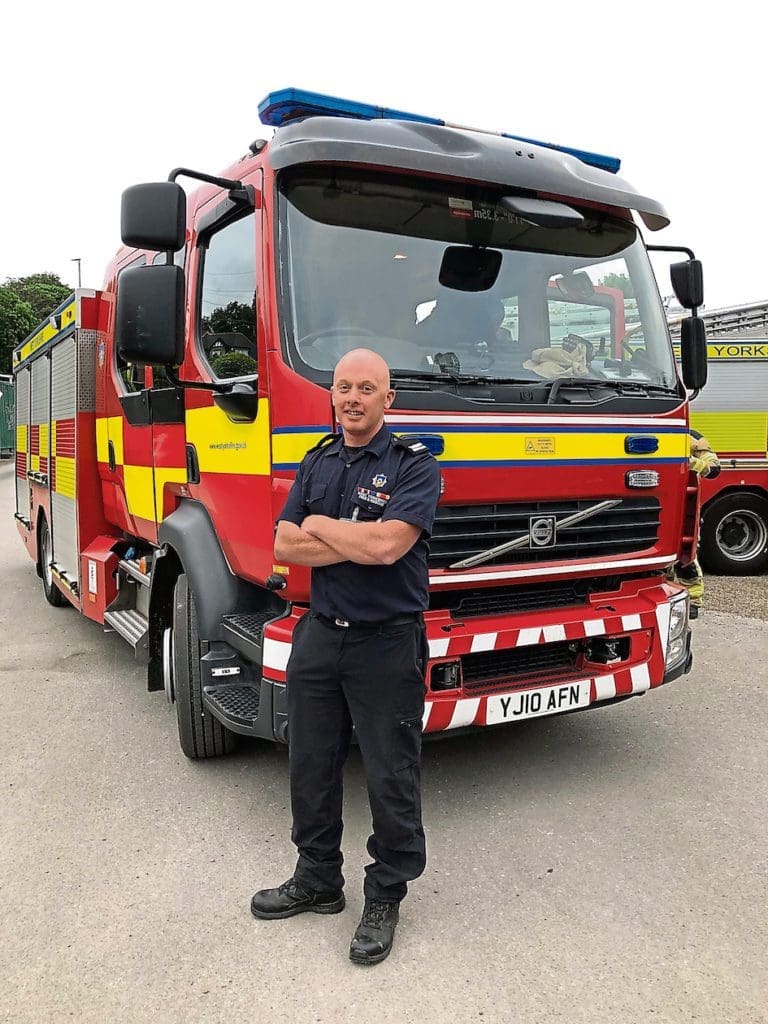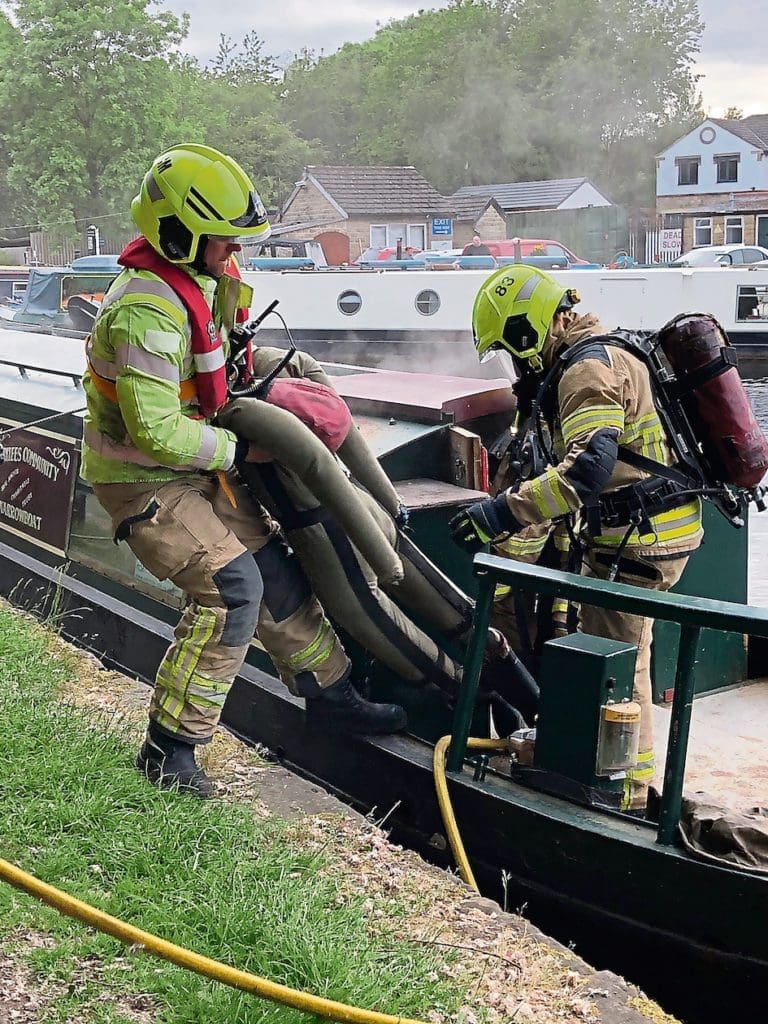West Yorkshire Firefighters have been doing their bit to promote boat fire safety awareness. Sally Clifford finds out more…
THE dramatic scene is set.
As the sun dips behind grey clouds that have consumed the sky for most of the day, the towpath is relatively busy with pedestrian traffic making the most of the lighter evenings.

The sight of dense smoke filtering out of the canalboat moored at Mirfield’s Shepley Bridge Marina prompted the ‘call’ from the marina’s ‘operator’ who had seen the boat arrive previously and understood there were two people onboard.
Had it not been for the Fire Safety Exercise sign on the towpath, passers-by would have been unaware the dramatic rescue operation unfolding in front of their eyes was actually a simulated training operation set up by West Yorkshire Firefighters as part of Boat Fire Safety Week.

Earlier in the evening the scene had been set. Artificial smoke pumped into Lady Rhodes, the 56ft long narrowboat – one of the five-strong fleet owned by the Safe Anchor Trust which kindly loaned the vessel, along with arranging the use of the marina, for the exercise organised by Richard Gordon, crew manager at Rastrick, and Mirfield Fire Stations.
Richard, along with Paul Gurevitch, training support, who oversaw the operation, placed two lifeless dummies in the cabin before Richard hosted a briefing at nearby Mirfield Fire Station for Mirfield’s retained firefighters and Dewsbury’s Green Watch who were involved in the exercise.

Following the call to action, three pumps and 15 firefighters arrived on scene where they were met with their initial challenge – pulling two hose reels across the marina to the boat moored on the opposite side of the site.
Boat fires aren’t a common call-out, which made the training exercise all the more important for firefighters to use their initiative when faced with a challenging situation, and put their skills into practice.
Kitted out with breathing apparatus, first into the smoke-filled cabin was firefighter Michelle Armitage.
Michelle explained the safety of the crew is paramount. Working closely with her colleague through touch and feel in a visually challenging environment due to the dense smoke, they checked for potential dangers and hazards such as gas cylinders.
While they worked inside, locating and recovering the dummies from within the cabin, their colleagues set up a casualty care area on the towpath.

Water safety was another important consideration. “There are different jobs for different safety factors for the crews,” explained Richard.
“The primary aim is to rescue the people on board,” Michelle added.
The casualties were swiftly recovered and, following further safety checks, a PPV fan was used to ventilate the cabin.
Being prepared
Based at Dewsbury Fire Station, it was Michelle’s first canal boat rescue during her 11 years in the job; she was previously based at Manchester Fire Service.
“It is really interesting. You learn a lot in a real scenario” she said. “It is useful to do things like that. You don’t want them to happen but, if they do, you are prepared.”

Richard explained the importance of organising the operation for training and to support Boat Fire Safety Week, one of the regular Fire Kills campaign weeks which is supported by the Boat Safety Scheme (BSS), a public safety initiative owned equally by the Canal & River Trust and the Environment Agency.
It is the third time Richard has run the exercise with the help of the Safe Anchor Trust.
Established in 1995, the volunteer-run charity, based at Shepley Bridge Marina, provides canal boat trips for physically and mentally disabled groups as well as the socially disadvantaged through age or social isolation or deprivation.
Kevin Thorburn, a volunteer and trustee of Safe Anchor Trust, explained it is the third time they have been involved in a training exercise organised by the Fire Service.
“Our theme at Safe Anchor Trust is very much about community and helping others. Anything we can do to help our local community or boat owners we are definitely up for,” he said.
A spokesman for the BSS said: “Fire services are often at the front end of tackling boat emergencies on inland waterways and dealing with fires or other boating incidents can add extra risk when working on or next to water.
“So we urge boaters to take on board the advice from the fire services offered during Boat Fire Safety Week and try their best to keep themselves safe, for the sake of their own family and friends and to reduce the risk for potential responders to emergency situations.”
#towpathtalk #canals #canalsandrivers #narrowboat #rivers #waterways #lifeonthecut #boating #boats #canallife #canallifeuk





